Tiny Houses
Small Wonder: Top 10 Urban Sanctuaries for Tiny House Living

Welcome to our guide to the top 10 urban sanctuaries for tiny house living! Get ready to embark on a journey through hidden gems that will captivate your heart and soul.
We’ll take you to sustainable havens that embrace nature in the concrete jungle, converted warehouses bursting with industrial chic charm, and cozy cottages nestled in the heart of the city.
Discover the beauty of tiny house communities by the seaside and rooftop retreats with sky-high views. Join us as we explore these small wonders and find your perfect urban sanctuary.
Key Takeaways
- The Eco Oasis: Innovative design, eco-conscious living principles, reduction of carbon footprint, incorporation of renewable energy sources, integration of green spaces, contribution to the greater good of the planet
- Industrial Chic: Increasing popularity of industrial renovation and warehouse conversion, unique appeal of raw, industrial elements combined with cozy tiny house living, spaciousness and high ceilings of warehouses as a canvas for stylish living spaces, exposed brick walls adding character and warmth, large windows allowing for plenty of natural light
- Backyard Bliss: Tranquil oasis amidst the urban hustle and bustle, lush greenery, blooming flowers, and soothing water features creating a serene environment, private escape from the outside world, convenient access to amenities while still having a peaceful retreat, perfect for relaxation and rejuvenation
- Rooftop Retreat: Untapped potential of rooftops for tiny house living, breathtaking views and sense of freedom, utilization of vertical space in urban areas, contribution to rooftop farming and urban sustainability, sky-high views offering a peaceful escape from urban life
The Eco Oasis: A Sustainable Haven for Tiny House Dwellers
Our Eco Oasis is a sustainable haven for us tiny house dwellers. With its innovative design and eco-conscious living principles, our community is committed to reducing our carbon footprint while creating a harmonious environment.

Every aspect of the Eco Oasis has been carefully considered to promote sustainability. From the use of renewable energy sources to the incorporation of green spaces, our community is a shining example of sustainable design.
We believe in living in harmony with nature, and our Eco Oasis provides the perfect platform for us to do so. By embracing eco-conscious living, we not only benefit ourselves but also contribute to the greater good of the planet.
As we explore the charm of converted warehouses in the next section, we invite you to join us on this incredible journey towards sustainable living.
Industrial Chic: Discover the Charm of Converted Warehouses
Let’s explore the unique appeal of converted warehouses and discover the industrial chic they offer for tiny house living. Industrial renovation and urban warehouse conversion have become increasingly popular in the world of tiny house enthusiasts. There is something undeniably charming about the combination of raw, industrial elements and the coziness of a tiny house. The spaciousness and high ceilings of warehouses provide a perfect canvas for creating a stylish and functional living space. With exposed brick walls, concrete floors, and large windows, these converted warehouses offer a unique blend of rustic charm and contemporary design. They allow for creative customization and provide ample space for storage and personalization. Take a look at the table below to see some of the key features and benefits of living in a converted warehouse:

| Key Features | Benefits |
|---|---|
| Exposed brick walls | Adds character and warmth |
| High ceilings | Creates a sense of spaciousness |
| Large windows | Allows for plenty of natural light |
If you’re seeking an alternative and stylish living option, consider the industrial chic of converted warehouses for your tiny house journey.
Backyard Bliss: Cozy Cottages in the Heart of the City
We adore the charm and tranquility of cozy cottages nestled in the heart of the city. These backyard retreats offer a peaceful oasis amidst the hustle and bustle of urban life. Here are three reasons why we believe these city gardens are the ultimate blissful escape:
-
Serene Sanctuaries: With their lush greenery, blooming flowers, and soothing water features, these city gardens create a serene environment where you can unwind and recharge. The beauty of nature surrounds you, providing a sense of calm and tranquility.
-
Private Paradise: These cozy cottages offer a private escape from the outside world. Whether you want to curl up with a good book in a hammock or enjoy a cup of tea on a sun-drenched patio, these backyard retreats provide a peaceful haven where you can relax and rejuvenate.

-
Convenient Connection: Living in the heart of the city doesn’t mean sacrificing access to amenities. These cozy cottages offer the best of both worlds – a private oasis just steps away from restaurants, shops, and cultural attractions. You can enjoy the vibrancy of urban living while still having a tranquil retreat to call home.
Indulge in the pleasure of backyard bliss with these cozy cottages in the heart of the city. Experience the beauty of a city garden and create your own private sanctuary.
Rooftop Retreat: Tiny Living With a Sky-High View
When it comes to urban living, rooftops offer a world of untapped potential. Imagine the breathtaking views, the fresh air, and the sense of freedom that comes with living high above the city streets.
With tiny houses, we’ve the unique advantage of taking advantage of this altitude. Rooftop retreats not only provide a sky-high view, but they also offer a sanctuary in the midst of the bustling city, allowing us to escape the chaos and find solace in our own little piece of the sky.
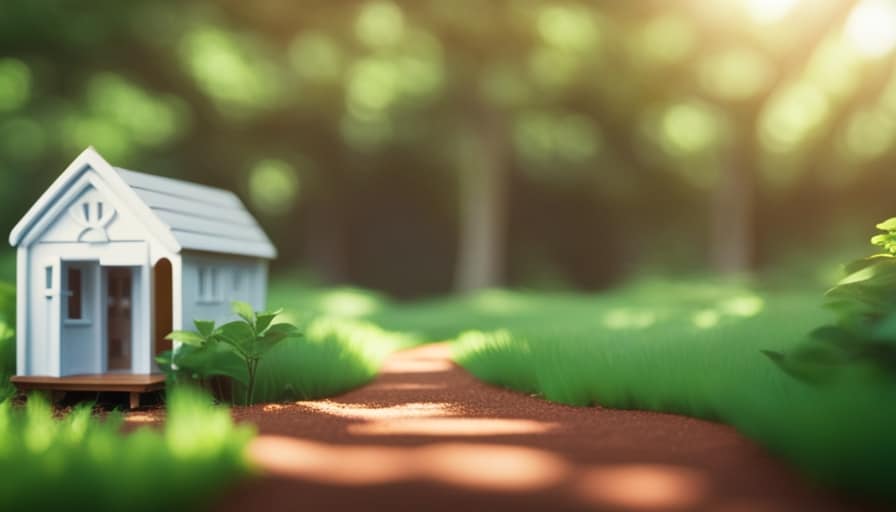
Urban Rooftop Potential
Living in a tiny house with an urban rooftop retreat offers us a sky-high view and an incredible sense of tranquility. The potential of utilizing rooftops in urban areas for tiny house living isn’t only exciting but also contributes to rooftop farming and urban sustainability.
Here are three reasons why urban rooftop living is a game-changer:
-
Maximizing space: With limited land availability in urban areas, rooftop living allows us to make the most of the vertical space. It provides an opportunity to create a cozy and sustainable living environment while utilizing previously unused areas.
-
Sustainable living: By incorporating rooftop farming into our tiny house retreats, we can contribute to urban sustainability. Rooftop gardens not only provide fresh produce but also help reduce the heat island effect, improve air quality, and promote biodiversity.

-
Sky-high views: Imagine waking up to breathtaking sunrises and enjoying stunning cityscape views from your rooftop retreat. The sense of serenity and connection with nature that comes with these views can be truly transformative, offering a peaceful escape from the hustle and bustle of urban life.
Embracing the potential of urban rooftops for tiny house living not only enhances our quality of life but also allows us to contribute to a more sustainable and vibrant urban ecosystem. Let’s explore the possibilities and create an urban sanctuary that serves both ourselves and the community.
Tiny House Altitude Advantage?
With its breathtaking vistas and endless possibilities, a rooftop retreat offers us an altitude advantage in tiny house living. Imagine waking up to the stunning view of the city skyline or the peaceful serenity of the surrounding nature. Living on the rooftop not only provides a unique perspective, but it also maximizes the limited space of a tiny house.
By utilizing the vertical space, we can create multi-level living areas, allowing for separate zones for sleeping, working, and entertaining. The elevated position also offers benefits like increased privacy, better ventilation, and natural light.

Furthermore, a rooftop retreat provides an opportunity to create a green oasis in the concrete jungle. We can transform the rooftop into a garden, growing our own food and enjoying the therapeutic benefits of nature.
With all these elevated living advantages, a rooftop retreat truly takes tiny house living to new heights.
Seaside Serenity: Coastal Tiny House Communities
We have discovered several breathtaking coastal tiny house communities that offer a serene and idyllic seaside living experience. Living by the coast in a tiny house allows you to fully immerse yourself in the beauty of nature while enjoying the benefits of a minimalist lifestyle. Here are three reasons why coastal tiny house communities are the perfect choice for those seeking seaside serenity:
-
Unparalleled Views:
Imagine waking up each morning to the sound of crashing waves and the sight of the sun rising over the horizon. Coastal tiny house designs often feature large windows and outdoor living spaces, allowing you to take full advantage of the stunning ocean views.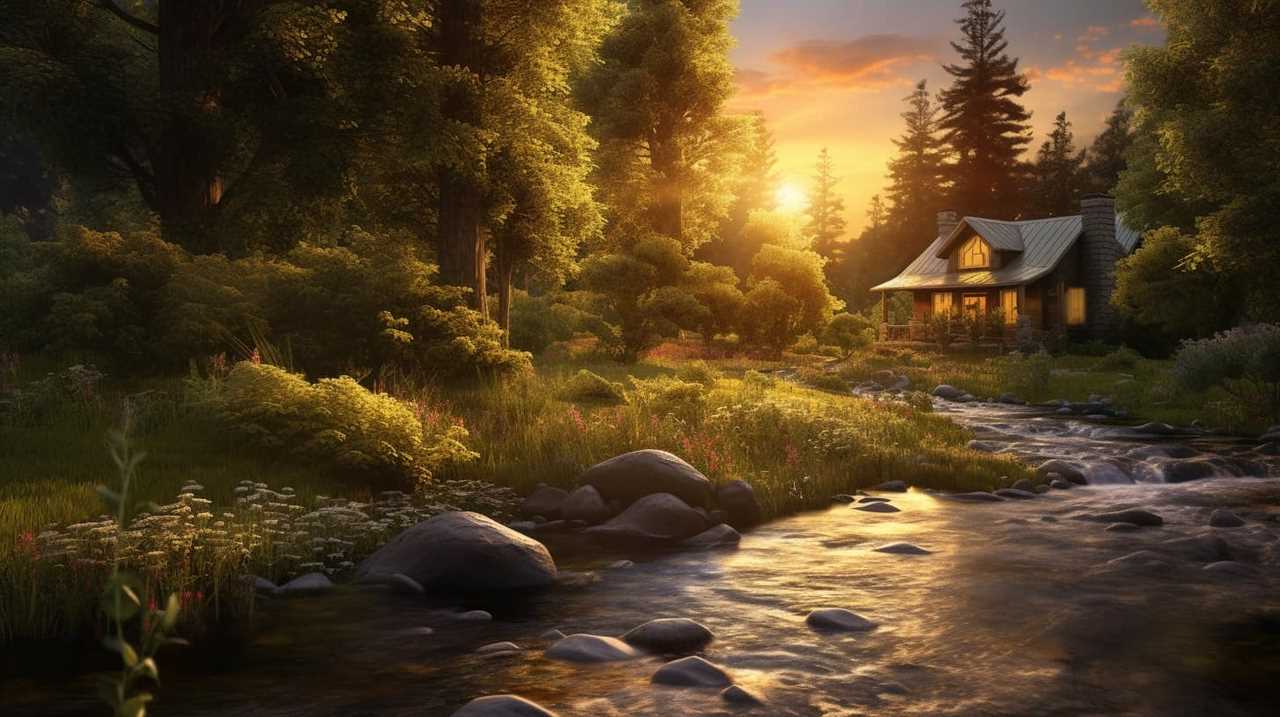
-
Beachside Activities:
From swimming and surfing to beachcombing and fishing, coastal living offers a wide range of outdoor activities. Living in a tiny house community by the sea means you can easily access these activities and make the most of your coastal lifestyle. -
Peace and Tranquility:
There’s something incredibly calming about being near the ocean. The sound of the waves, the salty sea breeze, and the vast expanse of water create a sense of peace and tranquility that’s hard to find elsewhere. Coastal tiny house communities provide a perfect escape from the hustle and bustle of city life.
Hidden Gems: Off-the-beaten-path Tiny House Enclaves
Hidden gems, off-the-beaten-path tiny house enclaves, are waiting to be discovered by adventurous souls seeking serene escapes from the crowds. These unexplored havens offer a chance to disconnect from the noise and reconnect with nature, allowing us to truly appreciate the simplicity and beauty of tiny house living.
Whether nestled in the mountains, hidden in the woods, or tucked away by a tranquil lake, these hidden gems provide a sense of peace and tranquility that’s hard to find in bustling urban areas.

Unexplored Tiny House Havens
One of our favorite unexplored tiny house havens is tucked away in the peaceful mountains of Colorado. This hidden gem offers a serene escape from the bustling city life, allowing you to reconnect with nature and find solace in simplicity.
Here are three reasons why this unexplored tiny house destination should be at the top of your list:
-
Breathtaking Scenery: Imagine waking up to panoramic views of snow-capped mountains and lush green valleys. This tiny house enclave offers unparalleled beauty that will leave you in awe.
-
Tranquil Atmosphere: Away from the noise and chaos of urban living, this hidden treasure provides a tranquil sanctuary where you can unwind and rejuvenate your mind, body, and soul.

-
Outdoor Adventures: Whether it’s hiking, biking, or fishing, this unexplored tiny house haven offers a plethora of outdoor activities to satisfy your adventurous spirit.
As we explore these uncharted tiny house havens, let’s now venture into the next section to discover serene escapes from crowds.
Serene Escapes From Crowds
What are some off-the-beaten-path tiny house enclaves that offer serene escapes from crowds?
If you desire to retreat from the chaos and find solace in serene nature, there are hidden gems waiting to be discovered. These peaceful havens provide the perfect sanctuary for those seeking peaceful solitude.

One such enclave is nestled deep within the majestic mountains, where the air is crisp and the views are breathtaking. Here, you can wake up to the sound of birds chirping and feel the gentle breeze rustling through the trees. Surrounded by towering pines and babbling brooks, you can immerse yourself in the tranquility of nature.
Another hidden gem lies by the serene shores of a secluded lake. Imagine waking up to the gentle lapping of water against the shore, with the sun peeking through the trees. You can spend your days kayaking, fishing, or simply lounging by the water’s edge, soaking in the peaceful ambiance.
These off-the-beaten-path enclaves offer a unique opportunity to escape the crowds and find solace in the beauty of nature. Whether you crave the serenity of the mountains or the tranquility of the lake, these hidden gems will provide the perfect respite from the hustle and bustle of everyday life. So, pack your bags and embark on a journey to these serene escapes. Your soul will thank you for it.
Urban Farmsteads: Embrace Nature in the Concrete Jungle
We love the idea of creating urban farmsteads in the concrete jungle, where we can embrace nature and cultivate our own food. Urban farming provides a sustainable way of living, allowing us to reduce our carbon footprint and have a direct impact on our environment.

Here are three reasons why urban farmsteads are a fantastic option for those who desire serving others:
-
Food Security: By growing our own food, we can ensure that we’ve access to fresh, nutritious produce. This not only improves our health but also reduces our reliance on long-distance transportation and industrial farming practices.
-
Community Building: Urban farmsteads bring people together, fostering a sense of camaraderie and connection. Through shared gardens and farm-to-table initiatives, we can create a vibrant and supportive community that values sustainability and self-sufficiency.
-
Educational Opportunities: Urban farming provides a unique learning experience for both adults and children. It allows us to reconnect with nature, learn about sustainable practices, and develop important skills such as gardening and composting.

By embracing urban farmsteads, we can create a greener, healthier, and more vibrant concrete jungle.
But let’s not forget about the historical havens of tiny houses in historic neighborhoods, where we can find solace in the past while embracing a sustainable future.
Historical Havens: Tiny Houses in Historic Neighborhoods
Let’s explore the charm and character of tiny houses nestled in historic neighborhoods, where we can truly appreciate the rich history and architectural beauty. These historical havens offer a unique opportunity to live in a tiny house while immersing ourselves in a community that values historic preservation and architectural significance.
Living in a tiny house in a historic neighborhood allows us to become part of a larger story. We can walk the same streets that generations before us have walked, and admire the well-preserved buildings that hold so much history within their walls. Each tiny house in these neighborhoods becomes a testament to the past, blending seamlessly with the existing architectural fabric.

Artistic Abodes: Celebrating Creativity in Tiny Homes
We can find inspiration and express our creativity by immersing ourselves in the artistic abodes of tiny homes. These tiny houses aren’t just functional living spaces, but also works of art that celebrate unique designs and showcase the creativity of their owners.
The tiny house movement has given rise to a new form of artistry, where every square inch of space is carefully crafted to reflect the owner’s personality and style. From vibrant murals and hand-painted furniture to innovative storage solutions and upcycled materials, tiny homes offer a canvas for creative interior decor.
The role of art in small spaces goes beyond aesthetics; it nurtures creativity and allows individuals to think outside the box. Celebrating tiny house artistry is a way to inspire others to embrace their own creativity and create spaces that truly reflect who they are.
Community Connection: Thriving Tiny House Villages
The article explores the thriving tiny house villages that foster a strong sense of community and connection among residents. These villages are more than just a collection of tiny homes, they’re vibrant communities where individuals come together to support and uplift one another.
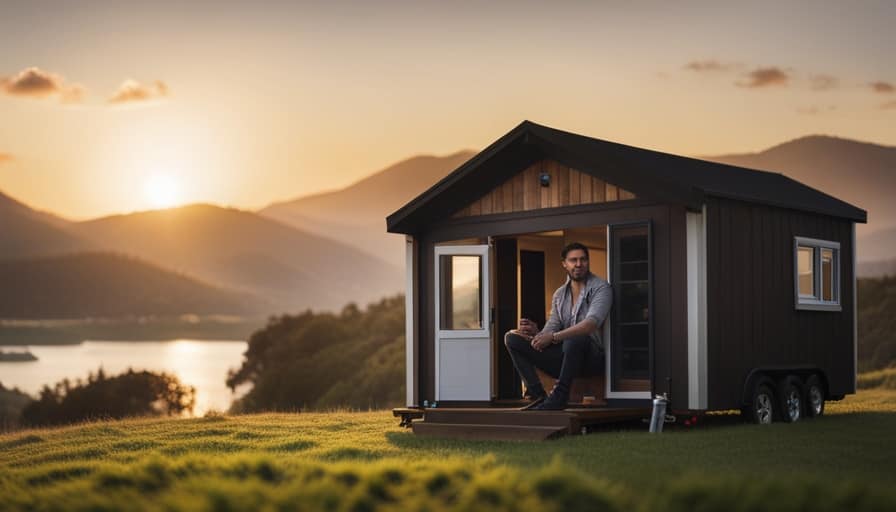
In these villages, residents share resources, ideas, and experiences, creating a thriving community that’s greater than the sum of its parts. The shared resources in these tiny house villages allow residents to live more sustainable and efficient lives. From communal gardens to shared laundry facilities, these villages are designed to promote a sense of togetherness and collaboration.
Living in a tiny house village not only offers the opportunity to simplify and downsize, but also provides a platform for individuals to connect and serve others in a meaningful way.
Frequently Asked Questions
Are There Any Financial Incentives or Tax Breaks Available for Living in a Tiny House?
Yes, there are financial incentives and tax breaks available for living in a tiny house. These incentives can help alleviate the financial burden and make tiny house living a more affordable and sustainable option for many.
What Are the Zoning Regulations and Legal Requirements for Parking and Living in a Tiny House in Urban Areas?
Zoning regulations, parking requirements, and legal considerations are important factors to consider when living in a tiny house in urban areas. It’s crucial to adhere to size and design restrictions while also managing utilities and sewage disposal. Additionally, exploring shared amenities and community spaces can enhance the tiny house living experience. Financial incentives and tax breaks may be available, so it’s worth researching potential benefits.
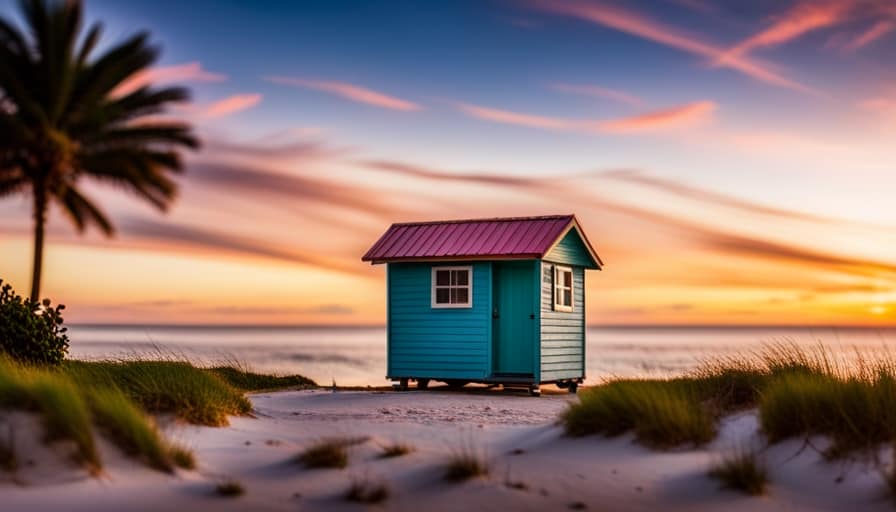
How Do Tiny House Communities Handle Utilities Such as Water, Electricity, and Sewage?
In tiny house communities, we have found innovative off-grid options for utilities like water and electricity. Additionally, we are passionate about waste management and have implemented creative solutions for sewage in urban areas.
Are There Any Restrictions on the Size or Design of Tiny Houses in the Featured Urban Sanctuaries?
There are size and design restrictions for tiny houses in the featured urban sanctuaries. However, these limitations are in place to ensure the safety and harmony of the community, allowing for a sustainable and enjoyable living experience.
Do These Urban Sanctuaries Offer Any Amenities or Shared Spaces for Their Residents?
Shared facilities and community activities are important aspects of urban sanctuaries for tiny house living. These spaces provide opportunities for residents to come together, share resources, and foster a sense of belonging and support.
Conclusion
In conclusion, these urban sanctuaries offer a breath of fresh air for those seeking a simpler, more sustainable way of life. They symbolize a rebellion against the confines of the modern world, embracing creativity, community, and connection with nature.

With their charm and character, these tiny house havens beckon us to step out of the chaos and into a world where less is truly more. Join the movement and find your own slice of paradise in these urban oases.
I’m Theodore, and I love tiny houses. In fact, I’m the author of Tiny House 43, a book about tiny houses that are also tree houses. I think they’re magical places where imaginations can run wild and adventures are just waiting to happen.
While tree houses are often associated with childhood, they can be the perfect adult retreat. They offer a cozy space to relax and unwind, surrounded by nature. And since they’re typically built on stilts or raised platforms, they offer stunning views that traditional homes simply can’t match.
If you’re looking for a unique and romantic getaway, a tree house tiny house might just be the perfect option.
Required Materials
How Do I Certify a Tiny House on Wheels

I was astonished to learn that there are more than 10,000 tiny houses on wheels in the United States, as someone who aspires to own a tiny house.
But how do I certify my own tiny house on wheels?
In this article, I will guide you through the process of understanding the certifications and regulations, researching building codes and standards, choosing the right certification agency, preparing the necessary documentation and plans, and successfully going through the certification process.
Let’s dive in and make your tiny house dreams a reality!

Key Takeaways
- Certifications and regulations for tiny houses on wheels vary by location and have cost implications and associated fees.
- It is important to research and choose a reputable certification agency that aligns with specific needs and goals.
- Preparing for certification involves contacting the local building department, seeking guidance from professionals, and ensuring compliance with building codes and regulations.
- Going through the certification process requires regularly updating documentation, double-checking compliance, submitting necessary documentation for review, and addressing any deficiencies or recommendations.
Understanding the Certifications and Regulations
I can understand the certifications and regulations for certifying a tiny house on wheels.
When it comes to certifying a tiny house on wheels, there are several factors to consider. One of the most important aspects is understanding the cost implications. Certifications and regulations can vary greatly depending on your location, and it’s crucial to be aware of any associated fees or expenses.
Additionally, exploring alternative certification options can help you find a solution that fits your needs and budget. Some certifications may be more affordable or offer different benefits than others. By thoroughly researching and understanding the various certification options available, you can make an informed decision that aligns with your goals and resources.
With this understanding in mind, it’s important to also research the building codes and standards that apply to your specific location and situation.

Researching the Building Codes and Standards
Researching the building codes and standards can help ensure that your tiny house on wheels meets all necessary requirements for certification. It’s important to familiarize yourself with the specific building code requirements and safety standards that apply to your area.
Here are some key steps to consider when researching the building codes and standards:
-
Contact your local building department: Reach out to your local building department to obtain a copy of the building codes and regulations that are relevant to your tiny house on wheels.
-
Consult with professionals: Seek guidance from professionals, such as architects or builders, who’ve experience with tiny houses on wheels and are knowledgeable about building codes and safety standards.

-
Join online communities: Engage with online communities and forums dedicated to tiny house living. These platforms can provide valuable insights and resources on building codes and standards.
Choosing the Right Certification Agency
Finding the right certification agency is crucial when certifying a tiny house on wheels. There are several certification options available, and it’s important to choose an agency that aligns with your specific needs and goals.
When selecting a certification agency, cost considerations should also be taken into account. Some agencies may charge a flat fee for the certification process, while others may charge based on the size or complexity of the tiny house. It’s important to weigh the cost of certification against the benefits it will provide, such as increased resale value and assurance of quality and safety.
Researching and comparing different certification agencies can help you make an informed decision and ensure that your tiny house on wheels meets all the necessary standards and regulations.

Preparing the Documentation and Plans
Once you have chosen the right certification agency, it’s important to regularly update and review your documentation and plans for your tiny house on wheels. Document submission is a crucial step in the certification process, and it’s essential to ensure that all required documents are complete and accurate. Compliance requirements can vary depending on the certification agency, so it’s important to carefully review their guidelines and specifications.
Here are three key points to consider when preparing your documentation and plans:
-
Organize your documents: Keep all your paperwork in one place and create a system for easy access and retrieval.
-
Double-check compliance: Review the compliance requirements regularly to ensure you’re meeting all necessary standards.

-
Seek professional guidance: If you’re unsure about any aspect of the documentation or plans, consult with professionals who’ve experience in the certification process.
Going Through the Certification Process
Navigating the certification process can be a time-consuming and complex task, but it’s crucial for ensuring the legitimacy and compliance of my tiny house on wheels.
To begin, I need to research the certification requirements specific to my location. Each jurisdiction may have different regulations and criteria that need to be met. This could include minimum size requirements, safety standards, and zoning restrictions.
Once I’ve a clear understanding of the requirements, I can start gathering the necessary documentation and submitting it for review. It’s important to note that the cost of certification can vary depending on the jurisdiction and the complexity of the process. In some cases, it may involve hiring professionals such as architects or engineers to assist with the certification process.

However, the investment is worthwhile as it ensures that my tiny house on wheels meets all necessary standards and is legally compliant.
Frequently Asked Questions
How Much Does It Cost to Certify a Tiny House on Wheels?
Certifying a tiny house on wheels can be costly. The cost breakdown includes fees for inspections, permits, and certifications. The certification process timeline varies depending on the jurisdiction, but it typically takes several weeks to complete.
Can I Build My Own Tiny House on Wheels or Do I Need to Hire a Professional?
Building your own tiny house on wheels is possible, but it’s important to consider building regulations. Hiring a professional can ensure compliance and save you time and headaches.
Are There Any Specific Requirements for the Materials Used in the Construction of a Certified Tiny House on Wheels?
When certifying a tiny house on wheels, specific requirements must be met for the materials used in construction. These requirements ensure safety and durability. It’s important to consult with professionals familiar with certification processes to ensure compliance.

How Long Does the Certification Process Usually Take From Start to Finish?
The certification process timeline for a tiny house on wheels can vary depending on the specific requirements and regulations. It is important to prioritize certification to ensure compliance and safety standards are met.
Once My Tiny House on Wheels Is Certified, Do I Need to Renew the Certification Periodically?
Once certified, I must periodically renew my tiny house on wheels’ certification to ensure its validity. This renewal process is important as it guarantees compliance with regulations and ensures the safety and quality of my home.
Conclusion
After thoroughly researching and understanding the certifications and regulations,
researching building codes and standards,
choosing the right certification agency,
and preparing the necessary documentation and plans,
I successfully went through the certification process for my tiny house on wheels.
It was a challenging journey, but I’m proud to say that I crossed all the t’s and dotted all the i’s.

Now, my tiny house is certified and ready to hit the road,
proving that where there’s a will, there’s a way.
I’m Theodore, and I love tiny houses. In fact, I’m the author of Tiny House 43, a book about tiny houses that are also tree houses. I think they’re magical places where imaginations can run wild and adventures are just waiting to happen.
While tree houses are often associated with childhood, they can be the perfect adult retreat. They offer a cozy space to relax and unwind, surrounded by nature. And since they’re typically built on stilts or raised platforms, they offer stunning views that traditional homes simply can’t match.
If you’re looking for a unique and romantic getaway, a tree house tiny house might just be the perfect option.
Types of Tiny Houses
How Could You Get a Tiny House Out of a Clothes Rack Yard

I have always been intrigued by the concept of transforming small spaces into livable homes. When I discovered the idea of converting a clothes rack yard into a tiny house, I was immediately interested.
In this article, I’ll guide you through the process of assessing the space, designing the layout, choosing the right materials, and incorporating space-saving solutions.
Get ready to transform your clothes rack yard into a cozy and practical miniature home. Let’s get started!
Key Takeaways
- Utilize vertical space and clever storage solutions to maximize the use of limited square footage in a tiny house in a clothes rack yard.
- Consider using sustainable materials like bamboo, recycled steel, and straw bales to minimize environmental impact and ensure structural integrity.
- Implement space-saving storage solutions such as vertical shelving units, furniture with built-in storage compartments, and under-bed storage containers.
- Personalize the tiny house by utilizing wall space for personalized gallery walls, adding pops of color and personality, and accessorizing with textiles for comfort and warmth.
Assessing the Space: Understanding the Potential of a Clothes Rack Yard
As I step into the clothes rack yard, I’m amazed by the potential that lies within this small space. When it comes to constructing a tiny house, utilizing vertical space is key.

In a clothes rack yard tiny house, it’s crucial to make the most of the limited square footage available. By incorporating clever storage solutions such as vertical shelving units or hanging racks, you can maximize the use of the space and keep your belongings organized.
Additionally, outdoor living is an essential aspect of a clothes rack yard tiny house. Creating functional outdoor areas, such as a small patio or a rooftop garden, allows you to extend your living space and enjoy the fresh air.
Designing the Layout: Maximizing Functionality in a Tiny House
When designing the layout of my tiny house, I wanted to maximize functionality by carefully considering the placement of each element. Optimizing furniture was crucial in order to make the most of the limited space. I chose multi-functional pieces that served multiple purposes, such as a sofa that could also be transformed into a bed, or a dining table that could double as a workspace. This allowed me to have all the necessary furniture without sacrificing space.
Additionally, utilizing vertical space was essential in creating a practical tiny house layout. I installed shelves and cabinets that reached up to the ceiling, making use of every inch of available space. I also utilized wall-mounted organizers and hooks to hang items and keep them off the floor. By thinking creatively and finding innovative storage solutions, I was able to make the most of the vertical space and keep my tiny house organized and clutter-free.
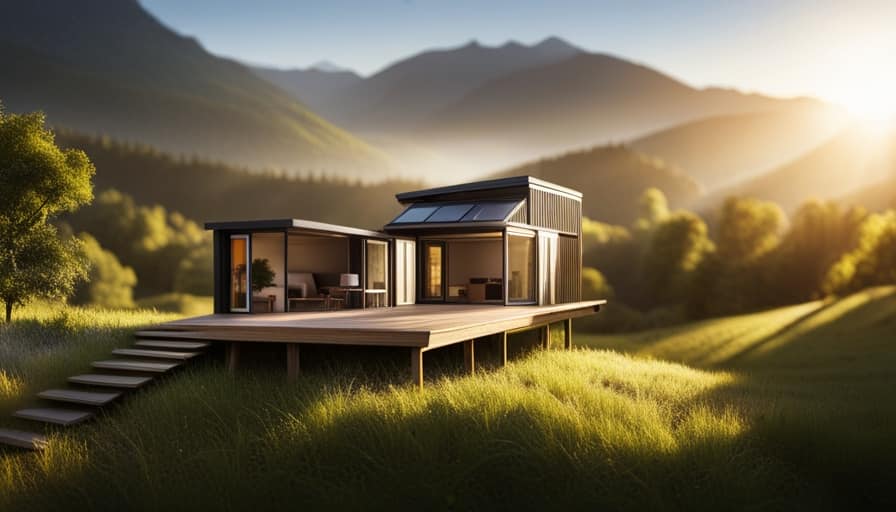
Choosing the Right Materials: Building a Sturdy and Sustainable Miniature Home
I can choose the right materials to build a sturdy and sustainable miniature home. When it comes to sustainable construction and using eco-friendly materials, there are several options to consider. Here is a table that outlines three materials that are both durable and environmentally friendly:
| Material | Description | Benefits |
|---|---|---|
| Bamboo | A fast-growing grass that is strong and versatile. | Renewable resource, high strength-to-weight ratio, natural beauty. |
| Recycled Steel | Steel made from recycled materials, reducing the need for new production. | Durable, fire-resistant, recyclable. |
| Straw Bales | Bales made from agricultural waste, providing excellent insulation. | Renewable, affordable, energy-efficient. |
Choosing these materials not only ensures the structural integrity of your miniature home but also minimizes your environmental impact. By incorporating sustainable construction practices and using eco-friendly materials, you can create a space that is both functional and environmentally responsible. With the right materials, you can build a sturdy and sustainable miniature home that will stand the test of time.
Now, let’s explore space-saving solutions and clever storage ideas for a clothes rack yard tiny house.
Space-Saving Solutions: Clever Storage Ideas for a Clothes Rack Yard Tiny House
With limited space in my clothes rack yard tiny house, I can utilize clever storage ideas to maximize the available area. Space saving tips and organizing hacks are essential for making the most of every nook and cranny in my small living space.

One idea is to use vertical storage solutions, such as installing shelves or hanging baskets on the walls. This allows me to keep items off the floor and free up valuable floor space.
Another clever storage solution is to use furniture with built-in storage compartments, such as ottomans or beds with drawers underneath.
Additionally, I can utilize under-bed storage containers or wall-mounted hooks to hang items like coats or bags.
Adding Personal Touches: Decorating and Making a Clothes Rack Yard Tiny House Feel Like Home
To truly make my clothes rack yard tiny house feel like home, I plan on sprucing it up with some personal touches and adding my own unique style. Here are some decorating ideas and personalization options that can transform a small space into a cozy and inviting home:

-
Utilize wall space: Hang photos, artwork, or shelves to display cherished items and create a personalized gallery wall. This will add visual interest and make the space feel more like your own.
-
Choose colors and patterns: Use paint, wallpaper, or fabric to add pops of color and personality to your tiny house. Incorporate patterns and textures that reflect your personal style and make the space feel vibrant.
-
Accessorize with textiles: Add comfort and warmth with soft throws, pillows, and rugs. Choose fabrics that you love and that make you feel at ease, creating a cozy atmosphere in your tiny house.
Frequently Asked Questions
How Much Does It Cost to Build a Tiny House Out of a Clothes Rack Yard?
To build a tiny house out of a clothes rack yard, the cost of materials can vary depending on your design and preferences. Additionally, check local zoning restrictions to ensure you comply with regulations.

What Are the Legal Requirements and Permits Needed to Build a Tiny House in a Clothes Rack Yard?
Legal requirements and permits needed to build a tiny house in a clothes rack yard vary by location. Contact your local zoning department to determine if it’s allowed and what regulations you need to follow.
Can a Tiny House Built in a Clothes Rack Yard Be Relocated Easily?
Relocating a tiny house from a clothes rack yard can pose challenges, but it’s doable. The benefits of using a clothes rack yard include affordability and convenience. Planning ahead and hiring professionals can make the process easier.
Can I Live in a Tiny House Built in a Clothes Rack Yard Full-Time?
Living full time in a clothes rack yard tiny house has its benefits. It offers affordability, simplicity, and a minimalistic lifestyle. However, ensuring the house is properly secured and easily movable is important for long term living.
How Long Does It Take to Construct a Tiny House Using a Clothes Rack Yard as a Base?
Constructing a tiny house using a clothes rack yard as a base requires careful planning, cost estimation, and resource management. The time required for construction depends on factors such as the complexity of design, availability of materials, and the skill level of the builder.

Conclusion
In conclusion, transforming a clothes rack yard into a tiny house is an exciting and challenging project.
By assessing the space, designing a functional layout, choosing the right materials, and implementing space-saving solutions, you can create a cozy and sustainable miniature home.
Adding personal touches with decorations will make it feel like home.
Just like how a wardrobe can hold a multitude of clothes, a clothes rack yard can hold endless possibilities for a unique and efficient living space.
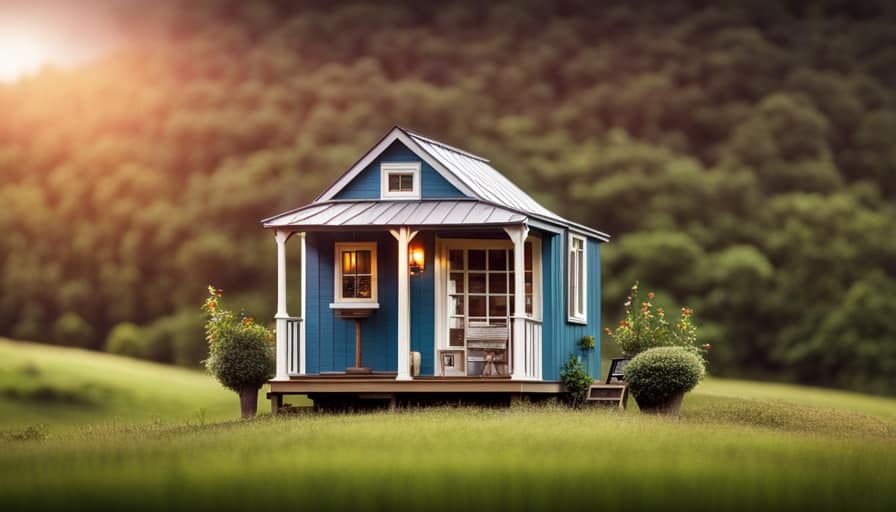
I’m Theodore, and I love tiny houses. In fact, I’m the author of Tiny House 43, a book about tiny houses that are also tree houses. I think they’re magical places where imaginations can run wild and adventures are just waiting to happen.
While tree houses are often associated with childhood, they can be the perfect adult retreat. They offer a cozy space to relax and unwind, surrounded by nature. And since they’re typically built on stilts or raised platforms, they offer stunning views that traditional homes simply can’t match.
If you’re looking for a unique and romantic getaway, a tree house tiny house might just be the perfect option.
Tiny Houses
Unlocking Petite Paradises: A Guide to Decorating Tiny Houses

Welcome to our guide on discovering small slices of paradise!
Are you ready to transform your tiny house into a cozy and stylish haven?
In this article, we will share our expert tips and tricks for decorating small living spaces with flair and functionality.
From maximizing space to choosing the right furniture, we’ve got you covered.

So let’s dive in and discover how to make the most of every square inch, creating a personalized oasis that truly feels like home.
Key Takeaways
- Utilize vertical space for storage and decor
- Choose light colors to create an illusion of spaciousness and brightness
- Incorporate mirrors to enhance natural light and create the illusion of a larger space
- Use multipurpose furniture and storage solutions to maximize functionality and save space
Maximizing Space in Tiny Houses
We absolutely love finding creative ways to maximize space in our tiny houses. In these petite paradises, every inch counts.
One of our favorite techniques for maximizing space is utilizing vertical space for storage and decor. When floor space is limited, it’s essential to think vertically.
We recommend installing wall-mounted shelves and cabinets to keep belongings off the floor and create a sense of openness. Hanging planters and artwork can also add a touch of personality while saving valuable floor space.

Another clever trick is using storage ottomans or benches with hidden compartments to store items that would otherwise clutter the living area.
Choosing Light Colors for Small Living Spaces
When it comes to choosing colors for small living spaces, we can’t underestimate the impact of light colors. Light colors have the power to make a space feel larger and more open, creating an illusion of spaciousness.
Impact of Light Colors
We always recommend choosing light colors for small living spaces as they create an illusion of spaciousness and brightness. Light colors have a significant impact on the overall feel and appearance of a tiny house.
Here are five reasons why light colors are beneficial for small living spaces:

-
Maximizing Natural Light: Light colors reflect natural light, making the space appear brighter and more open.
-
Enhancing the Perception of Space: Light-colored walls and furniture create an airy atmosphere, making the room feel larger than it actually is.
-
Promoting Relaxation: Soft, light colors have a calming effect, making the space feel peaceful and inviting.
-
Increasing Flexibility: Light-colored furniture can easily blend with different decor styles, allowing for more flexibility in design choices.

-
Creating a Welcoming Ambiance: Light colors create a warm and welcoming atmosphere, making the small living space feel homely and inviting.
Creating an Illusion
To achieve the illusion of a larger space, we suggest using light colors in small living spaces. Light colors, such as whites, pastels, and neutrals, have the ability to reflect more light, making a room feel brighter and more open. This optical illusion tricks the eye into perceiving more space than there actually is. By painting the walls, ceiling, and even furniture in light hues, you can create a seamless flow and visually expand the area. Additionally, incorporating mirrors strategically can amplify the illusion of space. Placing a mirror opposite a window will reflect natural light and give the impression of an additional window, further enhancing the sense of openness. Remember, the key is to keep the color palette light and airy to maximize the illusion of space.
| Pros of Light Colors | Cons of Light Colors |
|---|---|
| Creates an illusion of space | Can make a room feel cold |
| Reflects more light | Shows dirt and stains easily |
| Enhances natural light | May require frequent touch-ups |
Enhancing Natural Light
As we explore enhancing natural light in small living spaces, we can achieve this by choosing light colors for our decor. Light colors have the ability to reflect and amplify natural light, making a small space feel brighter and more open.
Here are some ways to incorporate light colors into your tiny house:

- Opt for a neutral color palette, such as whites, creams, and light grays, to create a clean and airy atmosphere.
- Use light-colored curtains or blinds that allow natural light to filter through while still providing privacy.
- Incorporate light-colored furniture and accessories to add brightness and visual space to your living area.
- Paint the ceilings and walls in light hues to maximize natural ventilation and create a sense of openness.
- Extend your living space outdoors by utilizing outdoor spaces with light-colored furniture and decor.
By incorporating light colors into your tiny house, you can enhance natural light and create a welcoming and spacious environment.
Now, let’s move on to the next section and explore how mirrors can open up tiny house interiors.
Using Mirrors to Open Up Tiny House Interiors
Our favorite trick for opening up tiny house interiors is to strategically place mirrors throughout the space.
Mirrors have the incredible ability to enhance natural light and create the illusion of a larger, more expansive area. By reflecting light, they help brighten up the space and make it feel airy and open. To maximize the effect, we recommend placing mirrors opposite windows or any other source of natural light. This not only enhances the brightness but also adds depth to the room.

Additionally, mirrors can be used to visually expand the space by reflecting other parts of the house. By strategically positioning mirrors on different walls, you can create a sense of continuity and make the entire tiny house feel more connected.
Mirrors are truly a game-changer when it comes to opening up tiny house interiors.
Picking the Right Furniture for Compact Living
We can achieve optimal functionality and comfort in tiny houses by selecting the right furniture and using space-saving techniques. When it comes to picking furniture for compact living, it’s important to prioritize maximizing functionality and utilizing every inch of space. Here are some space-saving solutions to consider:
- Multi-purpose furniture: Look for pieces that serve multiple functions, such as a sofa bed or a coffee table with hidden storage compartments.
- Wall-mounted furniture: Opt for wall-mounted shelves, foldable tables, and floating desks to save floor space.
- Modular furniture: Invest in modular furniture that can be easily rearranged and adapted to different needs.
- Built-in storage: Choose furniture items that come with built-in storage, like ottomans with hidden compartments or beds with drawers underneath.
- Folding furniture: Consider foldable chairs and tables that can be easily stored away when not in use.
By selecting the right furniture and incorporating these space-saving solutions, we can create a comfortable and functional living space even in the tightest of quarters.

Now, let’s explore how to utilize vertical space for storage and decor.
Utilizing Vertical Space for Storage and Decor
Maximizing vertical space is essential for achieving efficient storage and displaying stylish decor in tiny houses. In these petite paradises, every inch counts, and utilizing vertical space is the key to making the most of the limited square footage.
One way to do this is by incorporating hanging storage solutions. From floating shelves to hanging baskets, these clever storage options not only save valuable floor space but also add a touch of charm to your tiny house.
Additionally, vertical space can also be utilized for plants, bringing a breath of fresh air to your small abode. Hanging planters or wall-mounted plant holders are perfect for adding a touch of greenery without taking up precious counter space.

Incorporating Clever Storage Solutions in Tiny Houses
For small spaces, combining multifunctional furniture and creative storage solutions is crucial in order to maximize the limited square footage and keep our tiny houses organized. When it comes to clever storage ideas, there are countless options that can be incorporated into our tiny houses. Here are some space-saving furniture and storage solutions to consider:
-
Wall-mounted shelves and hooks: Utilize vertical space by installing shelves and hooks on the walls to store books, accessories, and kitchen utensils.
-
Under-bed storage: Invest in beds with built-in storage compartments or use under-bed storage containers to keep linens, clothing, and other items out of sight.
-
Foldable furniture: Opt for collapsible tables, chairs, and beds that can be easily stored away when not in use.

-
Over-the-door organizers: Hang organizers on the back of doors to store shoes, toiletries, and cleaning supplies.
-
Pull-out pantry: Install a pull-out pantry in the kitchen to maximize storage for food items.
Creating a Focal Point in Small Living Areas
When it comes to creating a focal point in small living areas, we need to think strategically. Maximizing wall space is key – consider hanging a large piece of artwork or installing floating shelves to display cherished items.
Another option is to place furniture strategically, such as arranging a cozy seating area around a statement coffee table or positioning a unique accent chair by a window to create a visual centerpiece.

Maximizing Wall Space
We can create a striking focal point in our small living areas by utilizing the wall space effectively. By maximizing wall space, we can enhance the overall design and functionality of our tiny houses.
Here are five creative ways to make the most of your walls:
-
Install floating shelves: These sleek and space-saving shelves can hold books, plants, or decorative items, adding both storage and visual interest.
-
Hang a gallery wall: Display your favorite photos, artwork, or prints in a curated arrangement to create a personal and eye-catching focal point.
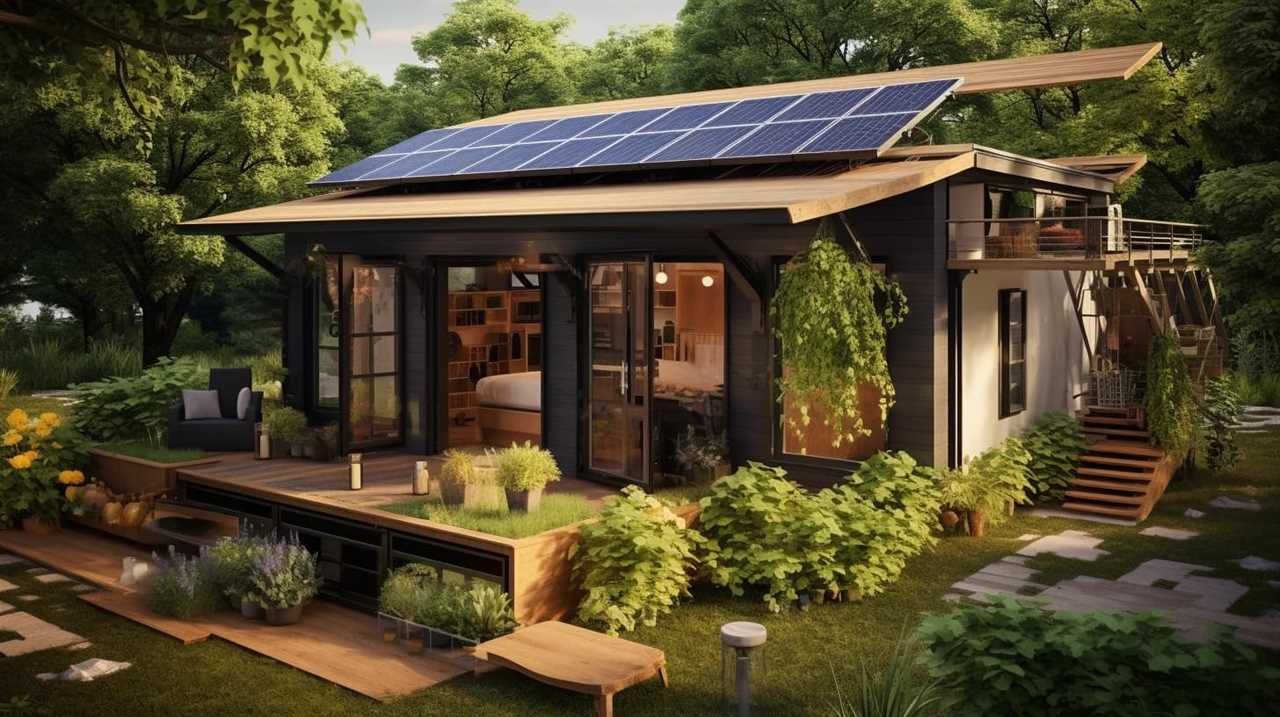
-
Use wall-mounted organizers: Opt for wall-mounted organizers to keep your small items neatly stored and easily accessible, freeing up precious floor space.
-
Hang mirrors strategically: Mirrors not only make your space appear larger, but they can also reflect natural light and create a sense of openness.
-
Incorporate wall-mounted lighting: Instead of floor or table lamps, choose wall-mounted lighting fixtures to save space and add a stylish touch to your small living area.
With these tips, you can transform your walls into functional and visually appealing elements in your tiny house, maximizing floor space and utilizing small nooks effectively.

Strategic Furniture Placement
By strategically placing our furniture and incorporating a focal point, we can make the most of our small living areas in tiny houses. Furniture arrangement plays a crucial role in space optimization, allowing us to create a functional and visually appealing layout. When arranging furniture, it’s important to consider the flow of the space and how each piece will interact with one another.
Placing larger furniture pieces against walls can help open up the center of the room, creating a sense of spaciousness. Additionally, incorporating a focal point such as a statement sofa or a beautiful artwork can draw the eye and add personality to the space. By thoughtfully arranging our furniture and creating a focal point, we can transform our small living areas into cozy and inviting spaces that maximize both style and functionality.
Now, let’s explore how adding a rug can enhance comfort and style in tiny houses.
Adding a Rug for Comfort and Style in Tiny Houses
To enhance the coziness and aesthetics of our tiny houses, we can’t go wrong with adding a rug for comfort and style. A well-placed rug can instantly transform a small space into a warm and inviting oasis.

Here are some tips for rug placement and materials that are perfect for tiny houses:
-
Layering rugs: If you have limited floor space, consider layering rugs to add depth and texture. Place a smaller rug on top of a larger one to create visual interest.
-
Choosing the right size: Opt for a rug that fits the scale of your tiny house. A rug that’s too large can overwhelm the space, while a rug that’s too small can make the room feel disjointed.
-
Durable materials: Look for rugs made from durable materials like jute or sisal. These natural fibers aren’t only stylish but also easy to clean and maintain.

-
Non-slip backing: In a small space, safety is paramount. Choose a rug with a non-slip backing to prevent accidents and ensure stability.
-
Pattern and color: Don’t be afraid to play with patterns and colors to add personality to your tiny house. Consider a bold geometric pattern or a vibrant pop of color to make a statement.
Personalizing Tiny House Interiors With Decor
As we delve into personalizing tiny house interiors with decor, it’s important to consider the use of versatile and multi-functional furniture pieces. In small living spaces, every square inch counts, so furniture that can serve multiple purposes is key. Look for items like storage ottomans that can double as seating, or foldable tables that can be tucked away when not in use.
Another way to personalize tiny house interiors is by incorporating plants. Not only do they add a touch of nature, but they also help purify the air and create a calming atmosphere. Consider hanging plants, vertical gardens, or even a small herb garden in the kitchen. By bringing the outdoors inside, you’ll create a sense of freshness and tranquility.

Now, let’s move on to the next section about using lighting effectively in small spaces.
Using Lighting Effectively in Small Spaces
Now, let’s explore how we can effectively use lighting in small spaces to create an illusion of openness and enhance the overall ambiance.
Lighting plays a crucial role in making tiny houses feel more spacious and inviting. Here are some tips for using lighting effectively in small spaces:
-
Utilize pendant lights: Hanging pendant lights from the ceiling can provide both functional and decorative lighting. They not only illuminate the space but also add a touch of elegance and style.
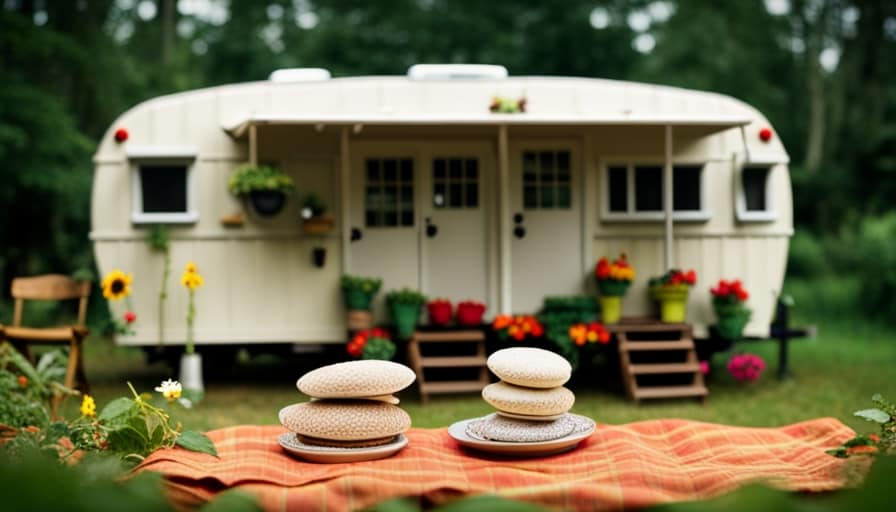
-
Install skylights: Installing skylights can bring in natural light, making the space feel brighter and more open. It also provides a connection to the outdoors, creating a sense of expansiveness.
-
Choose adjustable lighting: Opt for lighting fixtures with adjustable brightness levels to cater to different lighting needs throughout the day. This allows you to create different moods and atmospheres in your tiny house.
-
Use mirrors strategically: Placing mirrors opposite windows or light sources can help reflect and amplify the natural light in the space, making it appear larger and more spacious.
-
Opt for task lighting: Incorporate task lighting in areas where it’s needed, such as in the kitchen or workspace. This ensures that specific areas are well-lit, enhancing functionality and productivity.

Frequently Asked Questions
How Do I Deal With Limited Closet Space in a Tiny House?
When dealing with limited closet space in a tiny house, we maximize vertical storage by using shelves, hooks, and hanging organizers. We also get creative with clothing storage solutions, like under-bed storage and using multi-functional furniture.
What Are Some Creative Ways to Incorporate Plants Into a Small Living Space?
Incorporating plants into our small living space has been a delightful challenge. We’ve embraced vertical gardening with hanging planters, bringing vibrant greenery to every corner. It adds a touch of nature’s beauty to our petite paradise.
How Can I Make a Small Bathroom Feel More Spacious?
To make a small bathroom feel more spacious, we can create optical illusions by using light-colored tiles and mirrors. Utilizing vertical storage with shelves and hanging organizers can also maximize the space available.
Are There Any Tips for Maximizing Storage in a Tiny Kitchen?
When it comes to maximizing storage in a tiny kitchen, we’ve got you covered. From clever pantry organization tips to innovative storage solutions, we know how to make the most out of limited space.

What Are Some Space-Saving Ideas for a Home Office in a Tiny House?
To maximize productivity in a tiny home office, we recommend utilizing vertical space. Install floating shelves or wall-mounted storage units to keep your desk clear and organized. Don’t forget to add personal touches for inspiration!
Conclusion
In conclusion, decorating tiny houses can be a creative and rewarding process. By utilizing space-saving techniques and carefully selecting furniture and decor, small living spaces can be transformed into stylish and functional homes.
Did you know that according to a recent survey, the number of people living in tiny houses has increased by 67% in the past five years? This statistic highlights the growing trend of embracing minimalistic living and the importance of designing petite paradises that maximize space and style.
I’m Theodore, and I love tiny houses. In fact, I’m the author of Tiny House 43, a book about tiny houses that are also tree houses. I think they’re magical places where imaginations can run wild and adventures are just waiting to happen.
While tree houses are often associated with childhood, they can be the perfect adult retreat. They offer a cozy space to relax and unwind, surrounded by nature. And since they’re typically built on stilts or raised platforms, they offer stunning views that traditional homes simply can’t match.
If you’re looking for a unique and romantic getaway, a tree house tiny house might just be the perfect option.
-

 Beginners Guides1 week ago
Beginners Guides1 week agoHow To Buy A Tesla Tiny House
-

 Energy Efficiency1 month ago
Energy Efficiency1 month agoBest Tiny Homes For Cold Climates
-

 Beginners Guides5 days ago
Beginners Guides5 days agoTiny House Nation Where Are They Now Stephanie
-

 Tiny House Resources (e.g., legalities, cost, insurance, FAQs)2 months ago
Tiny House Resources (e.g., legalities, cost, insurance, FAQs)2 months agoDo Tiny Homes Need Planning Permission?
-

 Beginners Guides2 weeks ago
Beginners Guides2 weeks agoFrom The Show Tiny House Nation How Many Keep Their Tiny House?
-

 Beginners Guides2 months ago
Beginners Guides2 months agoUsing a Climbing Net For Treehouse Construction
-

 Beginners Guides2 months ago
Beginners Guides2 months agoHow to Build a Treehouse Without Drilling Into the Tree
-

 Beginners Guides3 weeks ago
Beginners Guides3 weeks agoTiny House Nation Who Pays For The Houses












